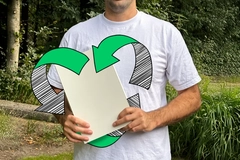Marine plastic litter satellite mission: PML researcher advocates for improved policymaking
01 Dec 2022 --- Plymouth Marine Laboratory (PML) Bio-Optical Oceanographer Dr. Victor Martinez-Vicente calls for a prototype satellite mission to help monitor the ever-increasing issue of marine plastic litter.
Published in Nature Reviews Earth & Environment, Dr. Martinez-Vicente evaluates remote sensing observations of litter accumulations. He researches where the technology can be best leveraged and calls for an international collaborative effort to develop a dedicated mission to monitor marine plastic litter.
Remote sensing of marine plastics “can provide sustained, standardized global observations of accumulations of plastics on coastal and river shorelines. These observations can then be used to identify highly impacted areas to help decision-making processes for policymakers. Satellite observations could also be used to monitor policy impacts,” Dr. Victor Martinez-Vicente, senior bio-optical oceanographer at Plymouth marine laboratory, UK, tells PackagingInsights.
“There is no current satellite mission with specific capabilities to target plastic accumulation in shorelines or rivers. However, a mission prototype has been recently proposed in Europe called Marlise. It would be great if industry and governments collaborated to make the proposed mission a reality.”
“Governments could obtain spatial coverage data of plastics on the shorelines and river banks, which would help reduce costs of monitoring through a combination of in situ and remote techniques, noting that satellite data still need appropriate validation from ground measurements to ensure accuracy,” he asserts.
Automated plastic waste detection from a boat.Monitoring crucial for fighting pollution
Monitoring marine plastic pollution requires repeated, long-term, global and harmonized observations of plastic presence, quantity and type, which satellites can provide. To convince space agencies to take action, coordinated activities are “urgently needed” to agree on target environments and to integrate in situ and satellite-derived measurements, stresses Dr. Martinez-Vicente.
Plastic litter makes up the largest proportion of human-originated solid waste material in the ocean, which is predicted to double by 2050. Given the ecological, economic and societal impacts of marine plastic litter, there is a need to end this pollution, as highlighted in the March 2022 resolution by the UN Environment Assembly to forge an international legally binding agreement by 2024.
To meet the aims of this anticipated agreement and evaluate its success, global monitoring of different marine environments will be essential.
Color sensing tech
Remote sensing technologies such as satellites, drones and light aircraft offer a much wider picture at a fraction of the resources needed to perform in situ sampling.
Recent research has shown that satellites that measure water color can detect marine litter aggregations along ocean fronts. However, distinguishing between plastic and vegetation in these accumulations still requires near-field observations from ships or further investigation of other techniques.
“Because plastics come in different colors, it can be challenging to interpret their light signal – the characteristic that can be picked up by sensors remotely. Through years of research, it has been found that different types of plastics have unique features beyond the visible part of the light spectrum (toward the short wave infrared) that allow for remote sensing detection,” explains Dr. Martinez-Vicente.
“Other remote sensing solutions, such as image analysis of a shape are unreliable as the shape could be any number of other objects. The advantage of color sensing in the shortwave infrared is that the features are unique to polymers, also potentially different among polymers.”
“However, it is very important to note that although we are talking about marine plastics, for this technique to work properly, plastics should be dry, as water significantly affects their light signal,” he adds.  Image taken by an aircraft during fieldwork to detect different types of plastic remotely.
Image taken by an aircraft during fieldwork to detect different types of plastic remotely.
Collective effort needed
Beyond oceanfront aggregations, there are other environments in which direct plastic litter detection is accessible to color-sensing satellites. Plastic accumulations along coastal and river shorelines can also be monitored this way, and therefore, a focus on these areas by a new satellite mission is recommended. If planned carefully, this mission could also benefit remote sensing studies on coastal biodiversity.
Overall, Dr. Martinez-Vicente asserts a concerted international effort to bring together a collaborative, global network for plastic litter monitoring is essential in order to help encourage nations and space agencies to invest in this future research, develop sensors that are fit for purpose, help establish baseline data, share knowledge and avoid costly duplication.
“A good example is the proposed prototype mini-sat mission by our Belgian colleagues, focusing on shorelines and plastic pollution pathways from land. This initiative needs the wider community to persuade nations and space agencies to take action.”
“With the ministerial-level European Space Agency Council meeting this week now is the time for action. The ocean cannot wait another two decades for this critical support from remote sensing of plastic litter,” he concludes.
By Natalie Schwertheim












